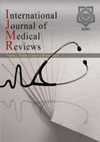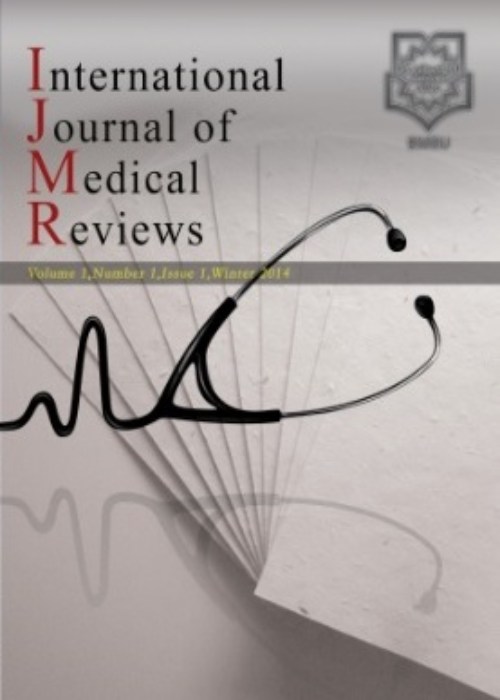فهرست مطالب

International Journal of Medical Reviews
Volume:7 Issue: 4, Autumn 2020
- تاریخ انتشار: 1399/10/07
- تعداد عناوین: 7
-
-
Pages 121-123
The use of Non-Invasive Ventilation (NIV) in patients with acute hypoxemic respiratory failure and specifically in Corona Virus Disease 2019 (COVID-19) that causes by severe acute respiratory syndrome coronavirus 2 (SARS-CoV-2) has been a matter for discussion since the current COVID 19 pandemic started. The limited available data led to conflicting opinions and variable recommendations and suggestions by the different health care professional bodies. Trends toward early intubation and avoiding NIV justified by the rapid deterioration of patients and the risk of disease transmission to the health care workers were prevalent mainly in the early stages of the pandemic. The limited available medical resources to provide invasive ventilation and subsequent anecdotal evidence suggestive of NIV success in patients with COVID 19 respiratory failure led to a change in the practice in different medical institutions around the world. Despite the absence of strong evidence, NIV probably has a role in the management of COVID 19 respiratory failure in a selected group of patients especially in the early stages of the disease via Continuous Positive Airway Pressure. Close monitoring and strict infection control precautions are required whilst providing NIV to avoid any possible complications.
Keywords: SARS-CoV-2: seververe acute respiratory syndrome coronavirus 2, NIV: Non-Invasive Ventilation, CPAP: Continuous Positive Airway Pressure -
Pages 124-130
Biomedical Waste (BMW) is any waste produced during the diagnosis, treatment, or immunization of human or animal research activities pertaining thereto or in the production or testing of biologics or health camps. Biomedical Waste Management (BMWM) is done in three stages – 1) Collection and separation, 2) Transportation to respective facilities 3) Proper treatment and disposal. Actually, BMWM has always been an issue in India. With the world in global crisis due to the recent outbreak of the Coronavirus Disease (COVID-19) pandemic, it has put great pressure on the BMWM system in India and around the world. To control the spread of the COVID-19 virus proper disposal of the waste is also necessary as it is a contagious disease and the waste generated during the treatment and laboratory tests are highly contagious and hazardous. This article investigates the situation of BMWM in India and studies whether the Indian BMWM system will be able to handle this increased amount of generated waste. The Indian government has given various guidelines to manage this increased biomedical waste overload. Data was gathered from literature search engines such as PubMed and Google Scholar, from verified newspapers and online news articles as well as from verified government websites.
Keywords: Biomedical Waste, Biomedical Waste Management, COVID-19, Coronavirus, Pandemic -
Pages 131-135
Aortic aneurysm is a cardiovascular disease that has a great deal of notoriety all over the world. If the diagnosis is postponed, there is a strong risk for rupture, leading to 90% mortality even before the patient arrives to the hospital. Treatment of aortic aneurysm is usually surgery in the form of open surgery or endovascular grafting. However, this type of surgery still has some disadvantages, including the safety profile and the risk of failure. Nanorobot surgery is a potential approach as a standard treatment for aortic aneurysm. The existence as a precision surgery will provide a better method of delivery. A combination with canonical Particle Swarm Optimization (PSO) and bionanocomposite could improve its effectiveness, operation and stability, creating a better nanorobot for aortic aneurysm therapy.
Keywords: AORTIC ANEURYSM, Nanorobot, Nanosurgery, Bionanocomposite -
Pages 136-139Aim
Few studies have been published about early surgical treatment of Rheumatoid Arthritis (RA). This article has aimed to describe the main procedures that may be performed in the hands of subjects at early stages of this disease.
MethodsThis research was a narrative review seeking comparative works in the Medline, LILACs and EMBASE databases.
ResultsThe publications showed good results associated with wrist synovectomy. There was a reduction in pain, greater patient satisfaction, and stabilization of the Larsen score. Synovectomy was indicated in these studies as an alternative procedure after three to four months of unsatisfactory clinical therapy. Another possibility of approaching these patients is the repair or transfer of ruptured tendons. Most studies have described this procedure in patients already with deformities secondary to RA and not in the initial phase of the disease. In this group of patients, the authors observed that the highest number of ruptures was associated with worse surgical outcomes. In most studies about wrists, radiolunate and RA were performed at more advanced stages, such as Larsen 3, and, even performed late, a clinical and radiological improvement was observed.
ConclusionIn this review, no studies with a high level of scientific evidence, testing early surgical interventions on the hands and wrists of patients with RA were found. Synovectomy, soft tissue repair, and arthrodesis are suggested as procedures that can be performed earlier than usual.
Keywords: arthritis, Rheumatoid, Synovectomy, Arthrodesis, Tendon Transfer, Early Diagnosis, adult -
Pages 140-145Introduction
Oral Potentially Malignant Disorders (OPMD) are chronic conditions that can progress to malignancy. Heat Shock Proteins (HSP) are a group of proteins that act as molecular chaperones. Actually, HSPs can promote the growth of tumor cells. On the other hand, they stimulate immune response against tumor cells. In this review it has been aimed to identify the role of HSP70 expression in the diagnosis and prognosis of OPMD.
MethodsIn this systematic review study, all English and Persian articles with the keywords of "oral lichen planus", " Leukoplakia ", " Oral Submucous Fibrosis ","heat shock protein 70", " oral premalignant disorders " along with their Persian equivalents were searched from Google scholar, PubMed, science direct, Cochrane, Scopus and Sid databases until March 2020. The quality of the selected studies were evaluated by the Newcastle-Ottawa scale method.
ResultsTotally, 20 articles were selected and reviewed. The results of this study showed that there was an overexpression of HSP70 in OPMD. A significant correlation of HSP70 expression was observed with the severity of epithelial dysplasia. Actually, the expression of HSP70 can be a marker for the presence of dysplasia in OPMD.
ConclusionEnhanced HSP70 levels in pre-malignant and malignant cells suggests that not only the oncogenes and tumorsuppressor genes are involved in the process of oral carcinogenesis, but HSP70s may also be implicated in tumorigenesis. Taking all these into account, it can be supposed that in the future, HSP70 can be a target for an anticancer immunotherapy.
Keywords: Heat shock protein 70, leukoplakia, Oral lichen planus, Oral Premalignant Lesion, Oral submucous fibrosis -
Pages 146-156IntroductionDrugs from the plants are easily available, less expensive, safe, and efficient and rarely have side effects. Glyphaea brevis leaf decoction is reported to be the potent treatment of sexually transmitted infections, abortifacient, ecbolic, and antiemetic, in eye treatment, liver problems and nasopharyngeal infections.MethodsThe aqueous, ethanolic and methanolic extracts of Glyphaea brevis sample were administered to the rats orally once daily at a dose of 250, 500 and 750 mg/kg, body weight for 30 days (on short-term effect) and 60 days (long-term effect). The hematological, biochemical parameters and histopathological examination were studied in the rats.ResultsThere was a significant difference within the hematological profile of the studied rats for all doses of the methanolic extracts of G. brevis (p < 0.05). The oxygen-carrying capacity of the blood and amount of oxygen delivered to the tissues of the rats had increased following extract administration. Alanine minotransferase (ALT), Aspartate aminotransferase (AST) and Alkaline phosphatase (ALP) levels of the albino rats at all dosage administered were statistically significant compared to the control. Histopathological examination showed kupffer cell activation in the liver, normal histology of the kidney and tubules, no signs of glomeronephritis, and mild coronary vascular congestion of the heart.ConclusionIt is proposed that G. brevis plant extract has a function of raising White blood cells WBC levels within a normal range such that it can efficiently and effectively fight infections. Treatment with the extracts suggested no impairment of normal kidney functions, thus could be considered as a natural product in the management of diseases.Keywords: Glyphaea brevis, Histopathological, Medicinal plant, Biochemical, Toxicity, Hematological, Albino Rats


